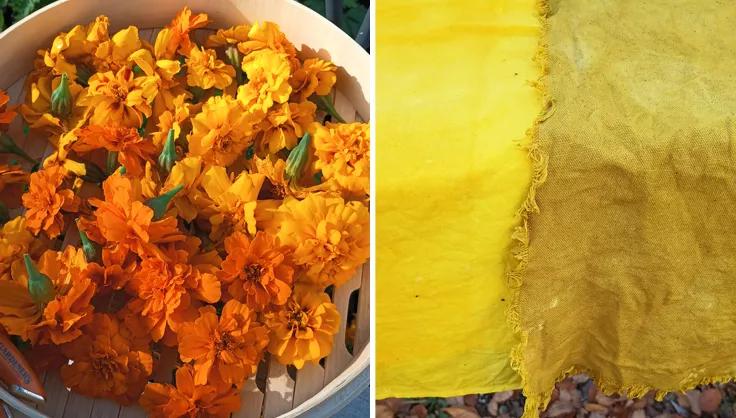How to Make Natural Dyes From Plants
Tips for Foraging and Growing Your Own Garden to Dye For

Gardeners grow plants for food, drink (thank you wine and coffee), shelter, medicine, soap, and oil — so why wouldn’t we try coloring our fabrics and fibers with them?
Jackie Reno, artist and owner of Van Reno Textiles in Burlington, Vermont, started dyeing small batches of cotton fibers with kitchen waste, like black beans, onion skins, and coffee grounds, years ago. Then she began experimenting with plants found sprouting up in her yard. “There are so many things you cannot get color from,” says Jackie. “So, when you find something that does work, it’s so exciting.”
A friend at the Garden Network later introduced Jackie to plants cultivated intentionally for their dyes, like indigo and chamomile, and the rest, was history.
Plants With a Purpose
Humans have been using plants to color fibers since long before recorded history. Madder (Rubia tinctoria) and safflower (Carthamus tinctorius) were used by ancient Greeks and Romans and were even discovered on dyed textile fibers found in Egyptian tombs. Until the creation of synthetic dyes in the mid 1800’s, plants were used to dye everything from fabric to leather to paper. Synthetic dyes, for all their commercial glory, have negative impacts on the environment, especially water quality.
Support for local food systems has been on the rise for decades now, and the more recent explosion of the "slow flower” movement has us all rethinking the commercial floral industry. As folks are starting to consider other aspects of their life in terms of sustainability, should it be any surprise that artisans and gardeners are returning to plant-based dyes?
Grown Versus Foraged
Many dye plants are true garden workhorses when it comes to multitasking: Marigolds repel insect pests and also can create a vibrate yellow when used as a dye. Calendula is an edible flower, can be used to make skin salves, and produces a lovely lemon yellow hue. Onions are, well, most of us know what onions are, but did you know you can make a beautiful brown dye from their papery skins? Most of these dye plants are easy to start from seed and grow freely in full sun and average garden soil.
In addition to growing her own dye plants in the garden, Jackie continues to search for naturally occurring local colors. While waiting on the garden to grow and fill out, she forages for acorns, spruce cones, and even the infamous pokeweed (which yields a gorgeous purple dye!).
Interested in foraging for dye plants? Like any foraging excursion, be sure to get landowner permission prior to crossing property lines AND take an identification key with you; some plants that produce great dye can also look similar to poisonous species.
Common Dye Plants To Grow and Forage
| Dye Plants to Start from Seed | Dye Plants to Forage |
|---|---|
| Marigold | Maple leaves |
| Calendula | Acorns |
| Sulfur cosmos | Pokeweed |
| Weld | Goldenrod |
| Dyers chamomile | Sumac |
| Japanese indigo | Black walnuts |
Colorfast
Many plants require pretreatment of fabric with a mordant, prior to dyeing. A mordant, or dye fixative, is a water-soluble metallic substance used to bind dye to fiber. Applying a mordant will ensure you have long-lasting, vibrant color. The actual final resulting color of your dyed item can depend on the fiber, the plant, and the type of mordant used. Commonly used mordents include:
- Alum: brightens the dye color
- Iron: darkens the dye color, produces brown and gray
- Copper vitriol: gives dyes a green hue
- Tin: produces bright colors, especially yellow and orange
Some plant colors adhere directly to fiber and do not require any mordants prior to dyeing; these are referred to as “direct” or “substantive” dyes. Black walnut, sumac, and turmeric all naturally contain tannic acid, which binds color to fiber without the additional assistance of a mordant.
Plant Dye Color Chart
Remember —most plants can produce more than one color, with the type of fiber and mordant dramatically changing the hue. This means there are countless colors to be created!
| Color Family | Plants |
|---|---|
| Yellows | Marigold, Dyer’s chamomile, Goldenrod, Yarrow |
| Oranges | Sulfur cosmos |
| Reds | Madder |
| Greens | Weld, Cannabis, Spinach, Buckthorn |
| Purples | Pokeweed, Blackberry, Red cabbage |
| Blues | Japanese indigo, Woad, Black beans |
| Browns | Onion skins, Walnut, Oak acorns |
Dyed in the Wool (and Other Fibers)
Plant dyes adhere best to natural fibers, such as 100% cotton, silk, linen, wool, or flax. Items that don’t need to be washed regularly will hold their color longer; scarves, cloth napkins, curtains, and tote bags are great items for dyeing. Until you familiarize yourself with the plants and the process, stick with simple textiles (and not treasured family heirlooms!).
How to Dye With Plants
We ventured out to the Gardener’s Supply test garden to collect an armload of marigolds and try plant dyes for ourselves. Here is a simple recipe to get you started:
 Photo: Freshly harvested marigolds (left), Fabric dyed with marigolds (right)
Photo: Freshly harvested marigolds (left), Fabric dyed with marigolds (right)- Wash your fabric in a natural or gentle (I.e., no added fragrance or softeners) detergent.
- Prepare your fabric mordant. Dissolve 2 tablespoons of potassium aluminum sulfate (alum) in 1 gallon of water and completely immerse your fabric in the solution.
- Soak the fabric in the mordant solution for up to 2 hours. Wring out the treated fabric and hang to air dry. Do not rinse.
- Harvest your flowers; we chose marigolds for a vivid golden yellow. Trim the flower heads from the stem and place them in a pot with clean water and bring to a boil. Simmer the marigold flower heads for 30 minutes.
- Remove the pot from the heat and carefully strain the flower heads from the water (and don’t forget to compost your flower scraps!)
- Place your treated fabric in warm colored water for 30 minutes; less if you prefer a lighter shade and up to an hour if you’d prefer a deeply saturated hue.
- Remove the fabric from the pot and hang it to dry in a well-ventilated, shaded area out of direct sunlight.
Can any gardener truly pick a favorite plant? When asked if she has an absolute favorite dye plant, Jackie laughed, “It changes all the time. The one I'm surprised by is typically my favorite.” She later added, “one of my favorite dye plants right now is cannabis — it really surprised me what a bright, bold, almost neon yellow with hints of green that comes from the leaves.”
Get ready to D-I-Y your own dye this season! What colors can YOU grow in your garden?
Print this Article:
Get the Dirt
Stay up to date on new articles and advice. Please fill out the information below.

